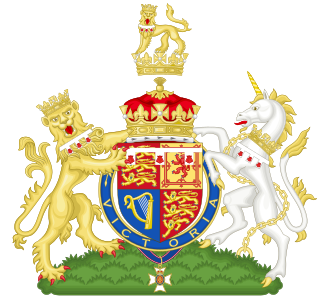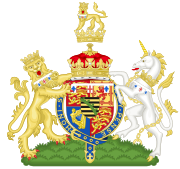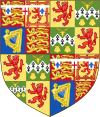The British royal family comprises King Charles III and his close relations. Charles is the head of the House of Windsor. There is no strict legal or formal definition of who is or is not a member, although the Royal Household has issued different lists outlining who is a part of the royal family. Members often support the monarch in undertaking public engagements, and pursue charitable work and interests. The royal family are regarded as British and world cultural icons.

Duke of Edinburgh, named after the city of Edinburgh in Scotland, is a substantive title that has been created four times since 1726 for members of the British royal family. It does not include any territorial landholdings and does not produce any revenue for the title-holder.

Prince Arthur, Duke of Connaught and Strathearn, was the seventh child and third son of Queen Victoria of the United Kingdom and Prince Albert of Saxe-Coburg and Gotha. He served as Governor General of Canada, the tenth since Canadian Confederation and the only British prince to do so.

Duke of Clarence was a substantive title created three times in the Peerage of England. The title Duke of Clarence and St Andrews has also been created in the Peerage of Great Britain, and Duke of Clarence and Avondale and Earl of Clarence in the Peerage of the United Kingdom. The titles have traditionally been awarded to junior members of the English and British royal family, and all are now extinct.
Duke of Cambridge is a hereditary title of nobility in the British royal family, one of several royal dukedoms in the United Kingdom. The title is named after the city of Cambridge in England. It is heritable by male descendants by primogeniture, and has been conferred upon various members of the British royal family several times throughout history.

Princess Alexandra, 2nd Duchess of Fife,, born Lady Alexandra Duff and known as Princess Arthur of Connaught after her marriage, was the eldest surviving grandchild of King Edward VII and also the first cousin of George VI. Alexandra and her younger sister, Maud, had the distinction of being the only female-line descendants of a British sovereign officially granted both the title of Princess and the style of Highness.

Duke of Sussex is a substantive title, one of several royal dukedoms in the Peerage of the United Kingdom. It is a hereditary title of a specific rank of nobility in the British royal family. It has been created twice and takes its name from the historic county of Sussex in England.

Alastair Arthur Windsor, 2nd Duke of Connaught and Strathearn was a member of the British Royal Family. He was the only child of Prince Arthur of Connaught and Princess Alexandra, 2nd Duchess of Fife. He was a great-grandson of Queen Victoria through his father and the first great-grandchild of Edward VII through his mother. He was also a descendant of Victoria's paternal uncle and predecessor, William IV, through an illegitimate line.

Duke of Fife is a title in the Peerage of the United Kingdom that has been created twice, in both cases for Alexander Duff, 1st Duke of Fife and 6th Earl Fife, who in 1889 married Princess Louise, the eldest daughter of Albert Edward, Prince of Wales. The dukedom of Fife was created for a member of the British royal family by marriage, since the first holder's wife was a granddaughter of Queen Victoria.

Princess Louise Margaret of Prussia, later Duchess of Connaught and Strathearn VA CI RRC DStJ, was a member of the House of Hohenzollern and of the British royal family. She served as the viceregal consort of Canada while her husband, Prince Arthur, Duke of Connaught and Strathearn, served as the governor general, from 1911 to 1916.

Duchess of Kent is the principal courtesy title used by the wife of the Duke of Kent. There have been four titles referring to Kent since the 18th century. The current duchess is Katharine, the wife of Prince Edward. He inherited the dukedom on 25 August 1942 upon the death of his father, Prince George, the fourth son of George V.

The use of the title of Princess of the United Kingdom of Great Britain and Northern Ireland is entirely at the will of the sovereign as expressed in letters patent. Individuals holding the title of princess are styled "Her Royal Highness" (HRH). On 18 April 1917, Frederica of Hanover, the newest granddaughter of Wilhelm II, German Emperor was styled a British princess from birth, even though Germany and Britain were fighting in World War I. Before the First World War, British princesses also held additional German titles, such as princesses of Hanover by virtue of being male-line descendants of George III; or princesses of Saxe-Coburg and Gotha, duchess of Saxony, by virtue of being male-line descendants of Prince Albert of Saxe-Coburg and Gotha. George V issued letters patent on 30 November 1917, to restrict the automatic assignment of the title "princess" and the use of the style "Royal Highness" to the following persons:
Earl of Sussex is a title that has been created several times in the Peerages of England, Great Britain, and the United Kingdom. The early Earls of Arundel were often also called Earls of Sussex.

Earl or Mormaer of Strathearn is a title of Scottish nobility, referring to the region of Strathearn in southern Perthshire. Of unknown origin, the mormaers are attested for the first time in a document perhaps dating to 1115. The first known mormaer, Malise I, is mentioned by Ailred of Rievaulx as leading native Scots in the company of King David at the Battle of the Standard, 1138. The last ruler of the Strathearn line was Malise, also Earl of Caithness and Orkney, who had his earldom forfeited by King Edward Balliol. In 1344 it was regranted by King David to Maurice de Moravia, a royal favourite who had a vague claim to the earldom as Malise's nephew and also stepfather.
Connacht or Connaught is a western province in Ireland.
In the British peerage, a royal duke is a member of the British royal family, entitled to the titular dignity of prince and the style of His Royal Highness, who holds a dukedom. Dukedoms are the highest titles in the British roll of peerage, and the holders of these particular dukedoms are princes of the blood royal. The holders of the dukedoms are royal, not the titles themselves. They are titles created and bestowed on legitimate sons and male-line grandsons of the British monarch, usually upon reaching their majority or marriage. The titles can be inherited but cease to be called "royal" once they pass beyond the grandsons of a monarch. As with any peerage, once the title becomes extinct, it may subsequently be recreated by the reigning monarch at any time.

Baron Carrickfergus is a title in the peerage of the United Kingdom, referring to Carrickfergus in County Antrim, Northern Ireland. Its current holder, since its creation on 29 April 2011, is William, Prince of Wales, who was granted the title as a personal gift by Elizabeth II, on the day of his marriage to Catherine Middleton. On the same day he was also created Duke of Cambridge and Earl of Strathearn, with his bride becoming "Her Royal Highness The Duchess of Cambridge" as well as Countess of Strathearn and Baroness Carrickfergus as a result of the marriage. Traditionally, when male members of the British royal family marry, they are granted at least one peerage. Catherine uses the title "Lady Carrickfergus" in a fuller version of her titles and styles, Her Royal Highness The Princess of Wales, Countess of Strathearn and Baroness Carrickfergus.

Baron Kilkeel is a title in the Peerage of the United Kingdom. It was created on 19 May 2018 by Queen Elizabeth II as a subsidiary title for her grandson Prince Harry, Duke of Sussex, upon the occasion of his marriage to Meghan Markle. It is named after the small fishing port of Kilkeel, County Down, with a population of 6,887, in the District of Newry, Mourne and Down in Northern Ireland. On the same day, he was also created Duke of Sussex and Earl of Dumbarton. Traditionally, male members of the royal family are granted at least one title on their wedding day by the monarch.
Prince Archie of Sussex is a member of the British royal family. He is the son of Prince Harry, Duke of Sussex, and Meghan, Duchess of Sussex. He is a grandson of King Charles III and is sixth in the line of succession to the British throne. He was born during the reign of his great-grandmother Queen Elizabeth II.

















